February – June 2010
- April 2010 Newsletter – April 2
- February 2010 Newsletter – February 4
April 2010 Newsletter
Shows and Exhibitions
Pala International News
- Pala’s Featured Mineral Specimens
- The Sinkankas Symposium 2010: April 17
- Larson to Give San Diego Talk: April 14
- Natural History Museum of Los Angeles County
Council’s 25th Anniversary Gala to Feature Bill Larson
Mineral and Mineralogy News
- BlueCap Issues New DVD, Solicits Input for Another
- The Recycle Bin – Items from Pala’s Gem News
- Tourmaline from Nuristan, Gemstones from Pakistan
- “It’s all about the people…”: Cornell collaboration will involve Pala’s Bill Larson
- “Elephant” Emerald Unearthed in Zambia
Shows and Sales
Houston Fine Mineral Show: April 30 – May 2, 2010
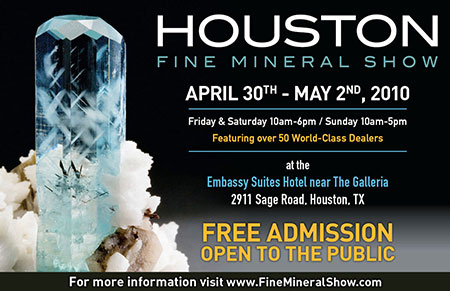 |
The Houston Fine Mineral Show is an exclusive show highlighting over 50 top mineral dealers. Pala International’s Bill Larson and Will Larson will be attending this year’s show.
Event: Houston Fine Mineral Show
When: April 30 – May 2, 2010
Where: Embassy Suites Hotel, Houston, TX
 |
Visit the Houston Museum of Natural Science
The Houston Fine Mineral Show allows us to promote one of our favorite museums and its stellar collection of mineral specimens: the Houston Museum of Natural Science. The museum’s Cullen Hall of Gems and Minerals “houses the world’s finest display-quality collection of gems and minerals,” according to its own website—and that’s no exaggeration. The hall’s display cases employ fiber-optic lighting and offer 360-degree views of more than 750 specimens that simply must not be forgotten while you’re in H-town.
See our story on a visit to the Cullen Hall by Pala’s Gabrièl Mattice in 2006; the snapshots she took will give a taste of what’s in store. And the gemstone enthusiast will want to catch the special exhibit “Fabergé: Imperial Jeweler to the Tsars,” which features the McFerrin Collection. [back to top]
Pala International News
Pala’s Featured Specimens: Two Hybrids
This month we feature two new and fascinating specimens. An intriguing malachite and shattuckite from the Kaokoveld region of Namibia and a hübnerite and quartz from Pasto Bueno, Peru.
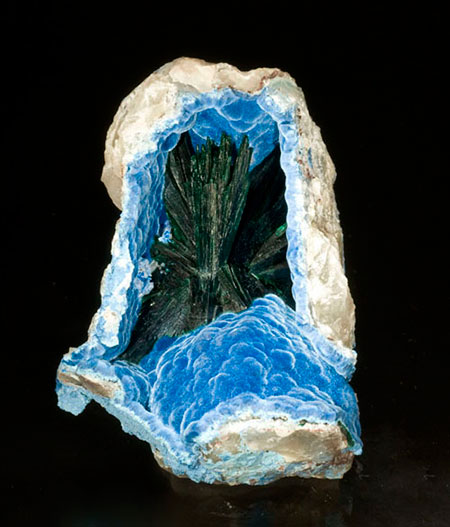 |
| Malachite in shattuckite from the Kaokoveld region of Namibia, 7.5 x 5.4 x 3.1 cm. Price upon request. (Photo: Jason Stephenson) |
Our first featured mineral is an amazing shattuckite vug with a acicular malachite spray. The shattuckite is in a blue velvety botryoidal form coating the inside of the little box-shaped vug. The malachite is a dark evergreen color with clusters of tiny needle-shaped crystals. Most crystals grow right into the walls of the pocket, but a few of them actually terminate at the top of the box, just kissing the shattuckite. A limited number of specimens of shattuckite and malachite have surfaced from the Kaokoveld region recently; the aesthetics and wonder that this piece holds go beyond all others of its kind.
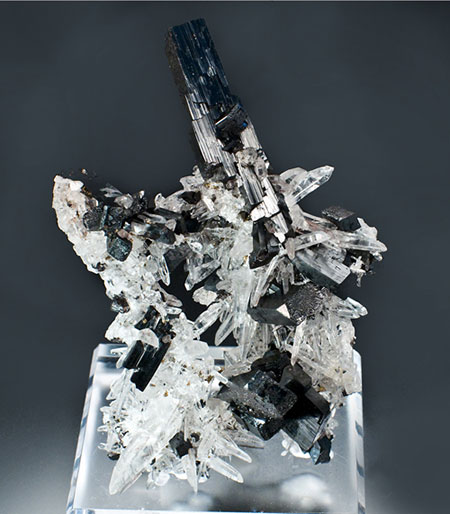 |
| Hübnerite and quartz from Pasto Bueno, Peru, 15.6 x 10.5 x 6 cm. Price upon request. (Photo: Mia Dixon) |
Our second feature is a dazzling display piece with a ring of jagged white quartz clusters contrasted by lustrous black hübnerite rods. Quartz crystals are slender and clear, ranging from a few millimeters to one 4 centimeters in length on the bottom left that is part of a Japan-law twin. The quartz is interwoven between the hübnerite, and actually penetrates in a few spots. The hübnerite crystals range from several millimeters to a complex 8-centimeter crystal that is perched atop the specimen. It’s a very chaotic and ornate arrangement that keeps drawing you in for a closer look. This magnificent specimen comes to us from Mundo Nuevo in the Pasto Bueno and Ancash Departments in Peru.
The Sinkankas Symposium 2010
Bill Larson to present on Gem Feldspar theme
The annual Sinkankas Symposium has been described by John Koivula as the “best gem mineral symposium in North America” and never fails to achieve sold-out enrollment. This year’s topic is Gem Feldspar, a subject made a bit more compelling by the unraveling of red feldspar issues that we looked at last October, in “A Mystery of the Orient.”
The Symposium, which will be held on Saturday, April 17, will feature Pala’s Bill Larson presenting on “World Class Collectable Gem Feldspars.”
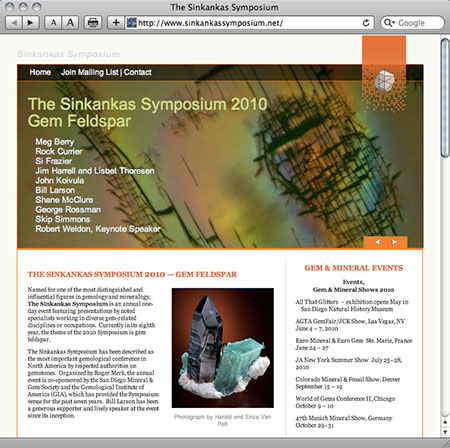 |
| The Sinkankas Symposium now has a handsome website of its own. |
The Symposium is organized by Roger Merk, and co-sponsored by the San Diego Mineral & Gem Society and the Gemological Institute of America. For more information see the new Sinkankas Symposium website. [back to top]
Larson to Give San Diego Talk
April 14 presentation in Carlsbad on Burma Gem Crystals
Can’t make the Sinkankas Symposium? The San Diego Chapters of the Women’s Jewelry Association and GIA Alumni Association are cosponsoring an event the prior Wednesday, for which they sent the following…
“Gem Crystals of Burma – The Source and Experience” will be presented by Bill Larson, President, Pala International.
Pack your passport….“Burma Bill” will take you on the experience he has traveled nearly two dozen times—into the valley of gems to one of the most historical resources for fine gems—Burma (now called Myanmar). Your journey will begin with history, and include the profound experience of visiting this land. You will also hear first hand, about the abundance of gems and minerals found, some of Bill’s guests/travel partners’ experiences to Burma, and the current trading issues that have resulted from the US embargo against Myanmar.
 |
| “Awed by the Fabulous Ruby Ngamauk.” Han Htun, FGA, and Pala’s Bill Larson, under the image of King Tibaw showing the royal ruby to author and gem merchant extraordinaire Edwin Streeter. Read the story of this ruby in our reprint of C. M. Enriquez’s “Fire-Hearted Pebbles from Burma.” (Photo: Bill Larson) |
The event is open to the public, and there is an admission charge (see below).
Event: Cosponsored by WJA/GIA Alumni
When: Wednesday, April 14, 2010
Where: La Costa Resort & Spa, Carnation Room
2100 Costa Del Mar Road, Carlsbad, CA 92009
800.854.5000
Program:
- 5:00–6:30 pm: Mix/mingle, no-host happy hour, at resort’s Blue Fire Grill
- 6:30–6:45 pm: Check-in and seating
- 7:00 pm: Bill Larson lecture begins promptly
PayPal payment may be made here. Reservation emails or questions to info@giasd.org or call Blaire Beavers at 619.279.3190. [back to top]
Natural History Museum of Los Angeles County
Council’s 25th Anniversary Gala to Feature Bill Larson
Museum Group’s May 2nd Event Is Open to the Public
The following notice was received this week. Congratulations to the Gem and Mineral Council on its first 25 years!
The Gem and Mineral Council of the Natural History Museum of Los Angeles County is celebrating its 25th anniversary with a gala event on Sunday, May 2nd, 2010. Billed as “An Evening to Remember,” the event will include dinner and drinks, silent and live auctions, historical photo essays, special museum tours—all in the beautiful setting of the museum and its world renowned Hall of Gems and Minerals.
The evening will culminate with a fascinating retrospective of the past 25 years in the world of gems and minerals by one of its most dynamic “players,” the inimitable Bill Larson.
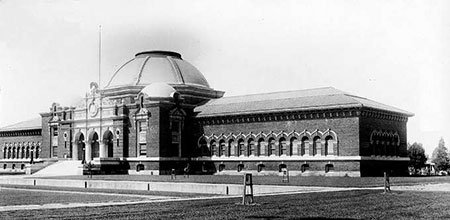 |
| The Natural History Museum has nearly 100 years of its own history. See this 95-year overview of gems and minerals at the museum. (Photo courtesy Natural History Museum of Los Angeles County) |
The public is invited, with a special invitation to past members. Tickets are $50 for members and $75 for non-members. RSVP required; contact Jean Brandt, 213.763.3326 by April 24th.
The Gem & Mineral Council, a members' group at the Natural History Museum of Los Angeles County, offers its members opportunities to advance their knowledge and enjoyment of gems and minerals within the unique context of the museum, including a varied schedule of activities including exciting field trips, educational lectures, and exclusive social events. More information on membership is available at the Council website. [back to top]
Mineral and Mineralogy News
BlueCap Issues New DVD, Solicits Input for Another
New Crystal Hunters: Arkansas
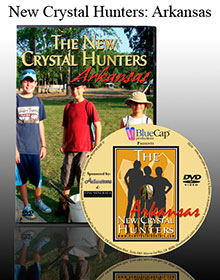 |
The second DVD in BlueCap Productions’ “New Crystal Hunters” series has been released, taking Mark, Damien, and Max to Arkansas. Locations explored include:
- Crater of Diamonds State Park, the world’s only diamond-producing site open to the public, under the tutelage of famous diamond hunter Glenn Worthington
- Ron Coleman’s Quartz Mine, where The Man himself shows the kid-crew how to search for world-famous Arkansas Quartz
- Along the way: visits to a water park, a 1,000-year-old Indian village, and a twilight ride up a 216-foot tower giving the kids a 140-mile view of Arkansas
More information on the series is available here. And remember friends of Pala International get a 10% discount on any BlueCap order. Just enter the code palaintl when you’re asked for it while ordering.
Next stop is Colorado, in time for next fall’s Denver show…
You’re the student. Write Jeff Scovil’s lesson plan…
That’s the challenge posed as part of a new BlueCap Productions project—a multi-disc DVD series that moves into the studio of master mineral and gemstone photographer Jeff Scovil.
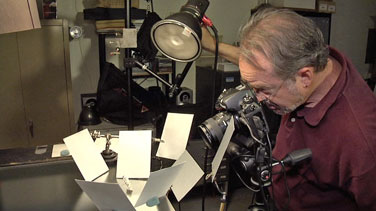 |
“Here’s where it gets interesting for you,” writes BlueCap’s Bryan Swoboda. “We’re asking you to help us shape the curriculum of this series. What is it that you want to see Jeff shoot?” Ideas can be sent to Bryan by email (include the subject SCOVIL MINERAL IDEAS), or posted on Facebook (see this link for more information on the project). [back to top]
The Recycle Bin
Here we point to items from Pala’s Gem News that pertain to mineral enthusiasts…
Tourmaline from Nuristan, Gemstones from Pakistan
A follow-up on our last edition’s story
In our previous edition of Pala Mineralis, we featured a photo essay, “Tourmaline Mining in Afghanistan,” contributed by a correspondent in southwestern Asia.
Coincidentally, via a mutual friend, we received a reply on that story from another correspondent, in Pakistan, who we hadn’t heard from in some time. (He had last notified us about a December 2005 avalanche in a peridot-mining region of Kohistan, in the North West Frontier Province border region and had commented on the state of the gemstone industry in Pakistan at the time.)
 |
| From Paprok, Nuristan. This tourmaline from Afghanistan consists of four prominent attached crystals. Good luster with glassy terminations. It measures 6.6 x 4 x 2.4 cm. Inventory #18086. (Photo: John McLean) |
Read his remarks on the tourmaline mining in the general area of the Mawi pegmatites in Nuristan Province.
And Pakistan?
Turning to another subject, and another country, we asked our contributor for a new assessment of Pakistan’s gem and jewelry industry. Four years ago, he’d admitted to being an optimist, but in the face of a reality that called for skepticism. Now, things are “still a little ‘rough’ but improving.” (Select the link above for the full story...)
 |
| From Shigar Valley, Baltistan. This specimen features a gemmy upper half and measures 11.4 x 2.6 x 2.3 cm. Inventory #18087. (Photo: John McLean) |
[back to top]
“It’s all about the people…”
Cornell collaboration will involve Pala’s Bill Larson
We recently caught up with Elise Skalwold, gemological curator at Cornell University. Our readers may recall “Viking Compass and the Usambara Effect,” which we cherry-picked from her website last June. Well, when she’s not festooning that website with streaming video of growing hydrothermal sapphire in a diamond anvil cell, for the past year she’s been working on a gem and mineral project that remains under wraps. When the curtain is pulled back, however, it will involve among other things a publication featuring photographs by Jeff Scovil, and will include a foreword by Pala’s Bill Larson, who also has kindly provided ad hoc advice along the way.
 |
| Classic Jeff Scovil “rough & cut” portrait. A 1.19-carat cut gem alongside its natural sister, a 1.70-cm. double-terminated crystal. Both originate from the Wah Wah Mountains, Beaver County, Utah (Cornell University gem and mineral collection). This appears in John S. White’s “U.S. Gemstones: An Overview” in the January/February issue of Rocks & Minerals. (Photo: Jeff Scovil) |
Leaving the mystery aside, we were taken by Elise’s description of the work involved in the ongoing project—a series of collaborative connections. “The context is gems and minerals,” she tells us, “but it is all about the people and the process.” She is honored to collaborate and be co-author with her dear friend and leader of the project, Cornell’s William Bassett, professor emeritus of geological sciences, and recipient of the Mineralogical Society of America’s highest award, the Roebling Medal. Oh, and “one of the pioneers of diamond anvil cell high pressure research,” she reminds us. But then you would have gathered that when you visited the link above.
Read the full story here. [back to top]
“Elephant” Emerald Unearthed in Zambia
The “elephant” has entered the room. A massive 6,225-carat rough emerald crystal has been pulled out of the Kagem mine in Zambia. The local Bemba people named the oversized green jewel “Insofu,” which translates as “elephant.” This remarkable specimen was found on February 5 and announced by the gemstone producer Gemfields. Evaluation of the true quality of this piece has not been released, but even from the simple picture below, one can see the strong color and high clarity. No doubt we will be seeing some mammoth faceted emeralds out of this very gemmy-looking piece of rough.
 |
| The “elephant” was named for its size, but also in honor of the World Land Trust’s “Wild Lands Elephant Corridor Project.” Promotion of the project will include the creation of “a bespoke collection of emerald jewellery, designed and created by the very best jewellers from around the world,” according to this International Colored Gemstone Association news item. See also this compelling preview of a forthcoming documentary on Asian elephants. (Photo courtesy Gemfields) |
Zambia has become an important source for emeralds as the world’s thirst for these green jewels grows. Other major producers include Colombia and Brazil, which have produced some record-settling emeralds as well. Colombia unearthed a 7,025-carat emerald crystal that actually held the record, but Brazil supposedly found the largest uncut emerald in 1974 that weighed 86,136 carats, according to The Daily Telegraph (UK) and Mindat.
For an overview of gemstone mining in Zambia, see this 2007 briefing paper prepared by the NGO groundWork.
Ron Ringsrud on the Elephant and El Itoco
Our friend Ron Ringsrud, author of Emeralds, A Passionate Guide, had this reaction to the Zambian find: “I am so impressed with the transparency of the ‘Elephant Emerald.’ It is astounding. It reminds me of the gem-quality transparency of the Itoco emerald.”
Ron should know; he facilitated the Itoco’s display last year at Southern California museums, as we reported. [back to top]
— End April Newsletter • Published 4/2/10 —
February 2010 Newsletter
In this edition of our newly dubbed Pala Mineralis e-newsletter we look at the relationships between the sensational specimen and the sentient subject. In the crystal: a whole world, stunning in its simplicity, but with a provenance packed with humankind’s complexities. And we appreciate the yearning of the artist to improve upon nature’s design, or perhaps to pay homage. Design, of course, is a human conceit, but one that is reflected in our every scratching of the sublunary surface.
Shows and Exhibitions
- Two Larsons to Present at Tucson
- Mineral Artists: Hildegard Könighofer and Gamini Ratnavira at Tucson
Pala International News
Mineral and Mineralogy News
- Into the Oh! Zone: A study of Himalaya Mine tourmaline
- Tourmaline Mining in Afghanistan
- The Recycle Bin – items from Pala’s Gem News
- All That Glitters: San Diego Museum Launches 2-Year Exhibition
- Mineralogical Almanac to Feature Bill Larson Article
Shows and Sales
Two Larsons to Present at Tucson
Bill Larson to Address Museum Group Next Thursday
 |
Pala International president Bill Larson will address the 2010 Tucson Meeting of The Society of Mineral Museum Professionals on the subject of Gem Crystals – Mogok, Burma. The meeting will be held during the annual extravaganza of gem and mineral shows in Tucson in late January and early February. The public is welcome to attend.
The Society of Mineral Museum Professionals (SMMP) is an international organization of mineral museum curators and others with related interests. SMMP is a non-profit, tax-exempt corporation incorporated under the non-profit laws of the State of Arizona.
Event: SMMP 2010 Tucson Meeting
When: Thursday, February 11, 4–5 p.m.
Where: Tucson Convention Center
Will Larson Featured at Westward Look This Saturday
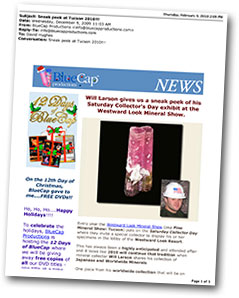 |
In October, we gave you a peek at what’s in store for vistors to the Westward Look Mineral Show this coming Saturday, February 6. Will Larson will be the “Collector Day” special guest for the annual spotlight, which will showcase his Japanese and worldwide collections.
In December, BlueCap Productions issued its own preview of this year’s Collector Day event.
In previous years, the event has featured collections from Gail and Jim Spann, Marshall and Charlotte Sussman, and Bryan Lees.
Event: Collector Day at Westward Look
When: Saturday, February 6, 10 a.m.–4 p.m.
Where: Westward Look Resort Lobby
[back to top]
Mineral Artists: Hildegard Könighofer and Gamini Ratnavira
Among several mineral portraitists to be featured at Tucson
The Tucson shows this year will offer exhibitions and a panel presentation by prominent mineral artists.
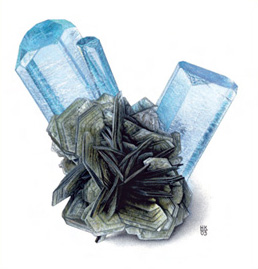 |
| Sample portrait from the book by Hildegard Könighofer. (Image courtesy BlueCap Productions) |
Westward Look will host the panel on Sunday, February 7. Panelists Eberhard Equit, Hildegard Könighofer, and Susan Robinson will join moderator Wendell Wilson for an overview of their work. The traditional pre-event cocktail hour will allow attendees to browse the work of several other artists, in a concurrent exhibition to feature Chris Hughes, Gail Spann, Fred Wilda, Gamini Ratnavira, Steve Sorrel, Brandy Naugle, Sarah Sudowski.
The Tucson Gem and Mineral Show exhibition of the four panelists’ work takes place February 11–14. According to the show brochure, the artists will “display some of their most impressive work next to the stunning gems and minerals that inspired them” and will spend time there to meet attendees.
We preview the work of two artists, Hildegard Könighofer and Gamini Ratnavira.
Hildegard Könighofer
A participant in both the Westward Look panel and TGMS exhibition, mineral portraitist Hildegard Könighofer will celebrate at Tucson the publication of a new book, The Mineral Art of Hildegard Könighofer. Accompanying 149 pages of the artist’s paintings are nine articles authored by twelve contributors on topics such as “Science vs Aesthetics,” “Appropriation and Reproduction,” and examinations of notable localities. The articles are presented in German and English, with German captions.
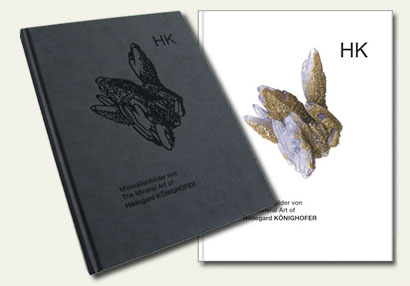 |
| Two editions are available, but are likely to go quickly. At left is the gray-leather limited edition, which includes a slipcase. The book is offered exclusively in the U.S. by BlueCap Productions. |
Austrian artist Hildegard Könighofer, along with her partner Dietmar Jakely (a contributor to the new book), is a mineral collector, and has illustrated her own specimens as well as those of the Naturhistorisches Museum Vienna, Landesmuseum Joanneum Graz, and many prominent local collections, according to this Mineralogical Record profile. Like Gamini Ratnavira, Könighofer also paints botanical subjects.
Gamini Ratnavira
Sri Lankan Gamini Ratnavira, whose life and work we profiled in December, is a close, close friend to Pala International, and in fact has his art studio and bird sanctuary on the Pala grounds. His paintings have focused on tropical plants and wildlife, but he has branched out into the world of mineral art with the help of Bill Larson’s choice subjects. He will be in Tucson, joining the group of mineral artists at this year’s Westward Look Show on Sunday evening.
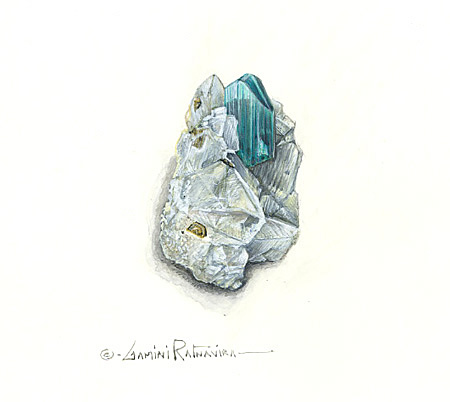 |
| A sample portrait by Gamini Ratnavira. Euclase from Colombia. (Illustrations courtesy of the artist) |
Growing up near the Sri Lankan mines of Ratnapura (“city of gems”), Gamini developed an eye and appreciation for minerals and began painting tourmalines in the 1990s for a forthcoming book by Bill Larson. (Sixty out of a projected 100 of the paintings have been completed.) Additionally Gamini has painted dozens of originals for the renowned mineral dealer Dr. Rob Lavinsky and appears annually at the Tucson Gem and Mineral show. Internationally collected, his artwork can be visited at his website and at his gallery on BlueCap Productions.
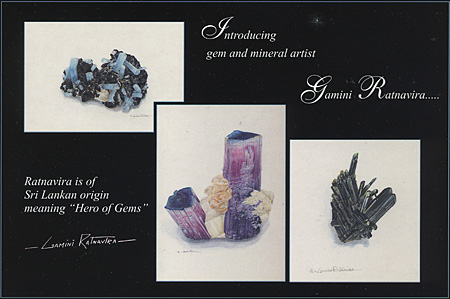 |
[back to top]
Pala International News
Pala’s Featured Specimen: Burmese Red Spinel
This edition we feature a Burmese red spinel with a single octahedral crystal, in conjunction with the theme of this year’s Tucson Gem and Mineral Show: gem crystals. As the world opens its eyes to new gem varieties, spinel is standing at the front of the line, intense and beautiful. Nothing better than a good ol’ fashioned flame-red spinel. This spinel exhibits the best Burma has to offer, with a slightly orangey red hue, high saturation, and a pleasing cushion cut.
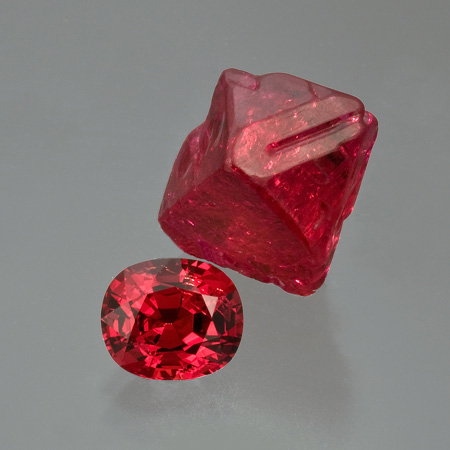 |
| Crystal & jewel: 2.24-carat Burmese faceted red spinel, 8.3 x 7 x 5.1 mm,, with 15-carat Burmese spinel crystal, 17 x 12 x 10.5 mm. Inventory #16655. (Photo: Mia Dixon) |
As we see many deposits producing fine spinels these days, with Tanzania, Tajikistan, Vietnam, Madagascar, and Sri Lanka, to name a few, nothing quite compares to some of the rich reds that are produced in Burma.
Interested? Select the inventory number above, call (telephone numbers below), or email us to inquire. [back to top]
Palaminerals.com
Pala International to debut website devoted to mineral specimens
Pala International will soon debut a new website, for the mineral devotee: Palaminerals.com. The website aims to offer the existing catalog (currently available from CollectorFineJewelry.com) in an updated format and with enhanced search capability.
We’ll notify both groups of our subscribers—minerals and gems—just as soon as the website goes online.
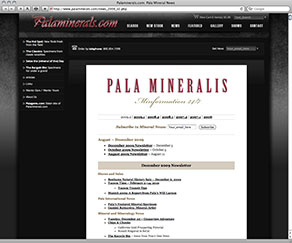 |
Will Larson, webmaster David Hughes, and Fallbrook IT pros Stephen Calia and Brent Dussia have guided the project through design and scripting phases. Features that users have come to rely on, via the sister site, Palagems.com, will be integrated into the site, including Mineral News from Pala International, which receives its new title and masthead, Pala Mineralis.
Why “Pala Mineralis”?
The literature of mineralogy predates the printing press of Johannes Gutenberg, himself a goldsmith and gem-cutter. Medieval mineralogical works, such as those by 13th century polymath Albertus Magnus, were some of the earliest to see the transition from manuscript to printed page, with his De Mineralibus Libri being published in 1476—only twenty years after the famous 42-line Bible. As stated in a bibliography by the late Curtis P. Schuh:
With Albertus Magnus' mineralogy, the study of minerals begins to emerge from its embryonic period into a full fledged science. The tradition of magical and curative powers in gems still permeates the text, but one feels the author fighting the superstitions of the ancient beliefs, and seeing the world in a new, more skeptical and practical view.
Although the coming renaissance would lead, as suggested above, to the Age of Reason, even Isaac Newton, as a scientist of his day, delved into alchemy and other esoteric investigations. And while the great age of the illuminated manuscript had since passed, illustrated manuscripts continued to be produced. One such work—perhaps at first glance more compelling for its arcane subject matter than its awkward imagery—is Cabala mineralis, a curious ~17th century alchemical treatise.
Alchemy was (is) concerned with investigation and, of course, transformation. And so it is both the curiosity-compelling and transformative power of nature’s creations, as we behold them, to which we pay homage in our echoing—rhyming, twinning—of a long forgotten alchemical text. Pala Mineralis. (Dulce et decorum est.)
The Virtual Museum beckons…
If the above discussion generates a jones for musty mineralogical tomes, a return visit to the Virtual Museum is in order.
 |
| Big Al. Yes, the Virtual Museum has a copy of De Mineralibus Libri; colophon: Patavii, Petrus Maufer for Antonius de Albricis, 20 September 1476. |
It’s been some time since we looked at the Virtual Museum of the History of Mineralogy. According to the December 2009 Museum newsletter, the most recent additions to the collections have been in the categories most viewed by visitors to the virtual displays: goniometers and crystal models.
Since mid-summer, nine of the instruments have been added, as well as a mid-19th century set of twinned feldspar crystal models—a gift from a prominent Berlin collector to a prominent Berlin crystallographer. Also added was a lovely set of indicators for specific gravity measurement, circa late 19th century.
Earlier, during the first six months of 2009, the museum’s curators Paul Tambuyser and Claude Hootelé nearly doubled the size of the book collection, adding two dozen a month. View the images from Christian Ernst Wünsch’s 1781 Briefwechsel über die Naturprodukte... and then take me to task for my remarks above about “awkward” illustrations. The stuff is glorious. As are the other volumes featuring illustrations (highlighted in the museum’s July 2009 newsletter). These surely will accelerate anticipation of this month’s Mineral Artists Show at Tucson. — David Hughes
[back to top]
Mineral and Mineralogy News
Into the Oh! Zone
A study of Himalaya Mine tourmaline
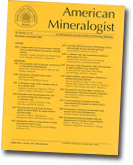 |
Color zoning in tourmaline is well known to enthusiasts of Southern California minerals. Pala’s Tourmaline Buying Guide includes a couple of lovely examples of the natural phenomenon.
Slices of bi-color “watermelon” tourmaline are the centerpieces around which jewelry creations are crafted. San Diego County’s Himalaya Mine, which has a role in our chronicle of Pala International’s 40 years in the trade, produced color-zoned tourmaline for more nearly the entire 20th century. This month, in the Mineralogical Society of America’s journal, American Mineralogist, a remarkable “strongly color-zoned crystal” from the Himalaya is amongst the mine’s specimens discussed at some length.
“Tourmaline of the elbaite-schorl series from the Himalaya Mine, Mesa Grande, California: A detailed investigation” (abstracted here) is a study authored by an international group from Europe and the U.S.: Andreas Ertl, George R. Rossman, John M. Hughes, David London, Ying Wang, Julie A. O’Leary, M. Darby Dyar, Stefan Prowatke, Thomas Ludwig, and Ekkehart Tillmanns.
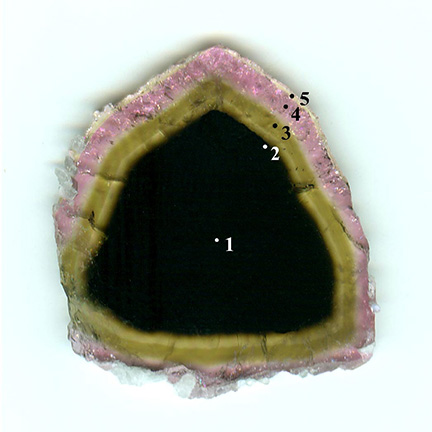 |
| Black and white… and so much in between, from a black core of “oxy-schorl” to an icing of colorless fluor-elbaite. (Photo courtesy George R. Rossman, California Institute of Technology) |
The study’s abstract discusses the rising, and sometimes falling, chemical profusions of elements in the color-zoned crystal, pictured above. Samples from the mine were investigated using a range of methods. The study concludes with a discussion of the formation of the tourmaline-bearing cavities in the Himalaya Mine’s dike.
 |
| Himalaya Mine tourmaline, above. A specimen typical of the mine’s fine production. Double-terminated, with cleavelandite and lepidolite. Three quarters pink with one termination a light cat’s eye green. See Inventory #14185. Tourmaline from Burma, below. Two terminated tourmaline crystals on a matrix with cleavelandite and quartz. Bottom side has black tourmaline with diffuse color zoning similar to that discussed in the American Mineralogist study. From Letpanhla, Mandalay Division, Mandalay District, Burma. See Inventory #17393. (Photos: John McLean) |
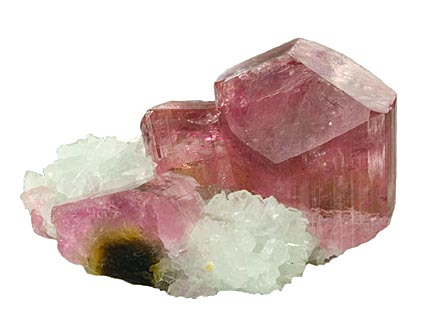 |
[back to top]
Tourmaline Mining in Afghanistan
Photos from the Mawi Pegmatites
We received the following photos from a new correspondent in southwestern Asia. The miners and mines are in the area of the Mawi pegmatites, in Nuristan Province, near its western border with Laghman and Panjshir Provinces. Palagems.com visitors may recognize this mining area from our reprint of Pierre Bariand and J.F. Poullen’s “The Pegmatites of Laghman, Nuristan, Afghanistan,” which appeared in Mineralogical Record in 1978. At the time of that writing, it was estimated that the principal vein was 40 meters thick, running for 1,200 meters.
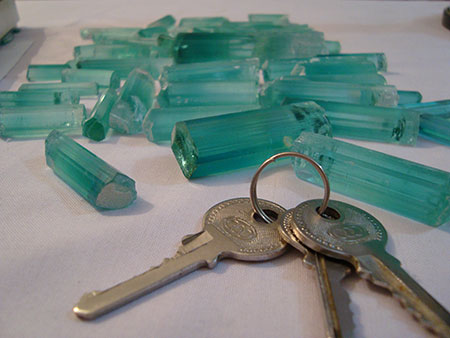 |
| Mawi tourmaline. This was one of the fine lots of tourmaline found in Mawi recently. |
Except for the map below, all photos and captions come from our correspondent, who used an alternate spelling of the pegmatite site, Maway, and the village, Gamatha.
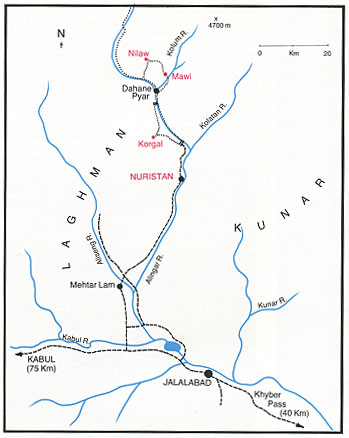 |
| Laghman–Kunar region. Mawi is about 300 pixels—er—90 km. north of Jalalabad. (Map from the Bariand & Poullen article reprint cited above, courtesy The Mineralogical Record) |
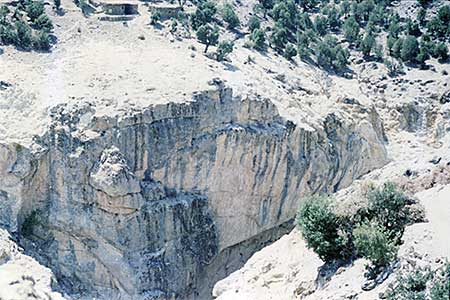 |
| Big. Mawi is one of biggest pegmatites in Afghanistan, famous for big pockets of spodumine, fine tourmaline, aquamarine, and many other pegmatatic minerals. The mountain shown is not a normal mountain; it is a huge pegmatite vein. |
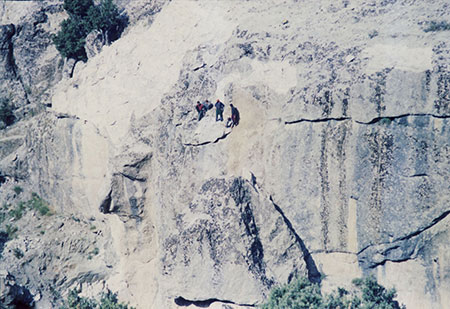 |
| Bigger. I took this photo to show the size of pegmatite compared with the human body. |
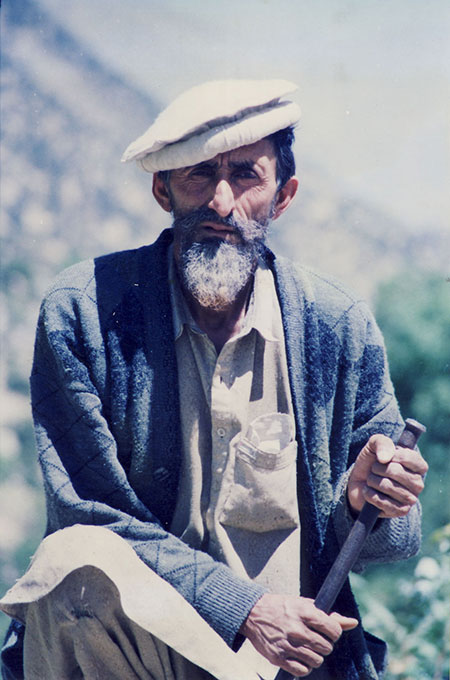 |
| Mr. Khoji is a miner in Gaamata, a village in the Mawi area, and has worked there for the last forty years. |
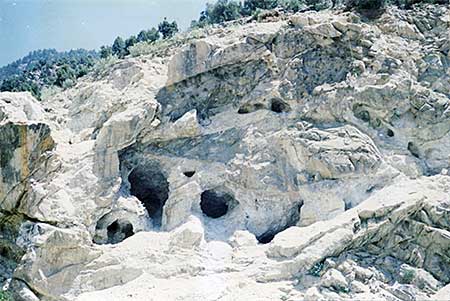 |
| Mawi mine. You can see the pegmatitic veins go in different directions than in a normal mountain. Below is another angle and at the bottom of the mine is the mining debris. |
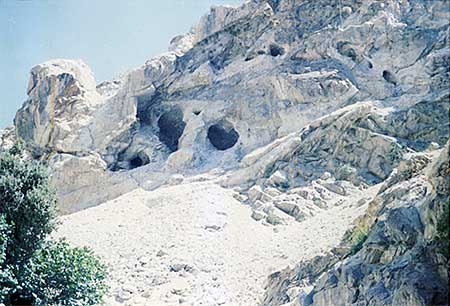 |
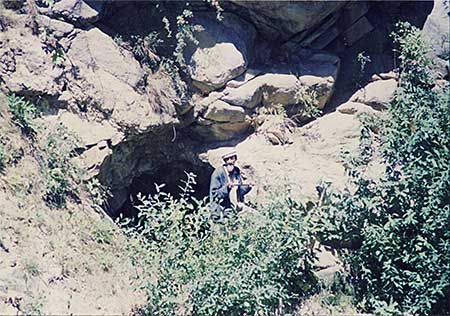 |
| Into the mine. Mr. Khoji is going to find some beautiful indicolite for me at Gaamata mine. |
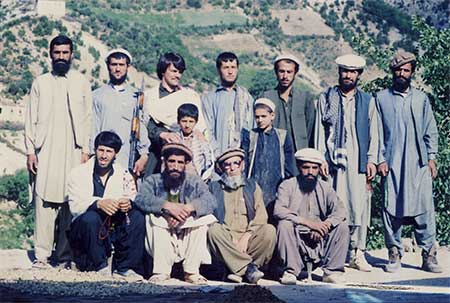 |
| The crew. This is the group of miners of Gaamata village. This area has some of the best indicolite in Afghanistan—having copper inclusions and changing to Paraíba-like color after heat treatment. |
Note: While results of the heat treatment of the indicolite, mentioned by our correspondent, may appear to approach “Paraíba-like color,” this is perhaps due more to the presence of iron rather than copper. See this exchange on GemologyOnline. [back to top]
The Recycle Bin
Here we point to items from Pala’s Gem News that pertain to mineral enthusiasts…
All That Glitters: San Diego Museum Launches
Two-Year Exhibition
Pala International to provide 100 gems and minerals
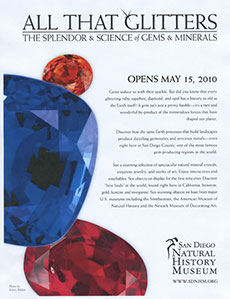 |
| Previews. Above, a promotional piece for the upcoming exhibition. Click on thumbnail to view full size. (Images courtesy San Diego Natural History Museum) |
The San Diego Natural History Museum is opening an exciting new exhibit for all those gem lovers out there. “All that Glitters: The Splendor & Science of Gems and Minerals” will include mineral specimens, faceted gemstones, and designer jewelry. It tells the story from the formation of gems within the Earth to Man’s creations employing all the wonderful gem materials. The exhibit will appropriately focus on the fascinating array of gems and minerals found in San Diego County, along with a wide variety from major gem producing regions around the Earth.
Over 100 gems and mineral specimens will be provided by Pala International. Prominent names in the industry like Tiffany & Co., Van Cleef & Arpels, and Cartier will provide a wide range of original jewelry pieces. Harvard University, the Smithsonian, the American Museum of Natural History, and the Museum of Fine Arts in Boston all will be adding to the extravaganza with more jewels and mineral specimens.
The exhibit opens May 15, 2010 and is scheduled to run through April 2012. “In addition to demonstrating the ‘splendor and science of gems and minerals,’ All That Glitters will have a playful side,” says Exhibition Curator and Graduate Gemologist Elise B. Misiorowski. “Jewels and carvings incorporating natural-history themes will give children as well as adults delightful surprises to hunt for. How many jeweled butterflies, birds, and flowers can you find? Which case contains the Faberge carved pig with diamond eyes?”
See the exhibition website for a look at the efforts underway to construct display installations as well as some of the pieces that will be included in the exhibition. The show’s inaugural week will culminate with the All That Glitters Gala. “The All That Glitters exhibition will seduce visitors with the beauty of these precious objects and fascinate them with the science of their formation, and the Gala will delight revelers with exquisite food, beautiful ambience and fantastic entertainment,” said Ellen Zinn, museum board member and Gala Chair, according to a press release containing more Gala details. [back to top]
Mineralogical Almanac to Feature Bill Larson Article
Russian journal’s next edition planned for Tucson
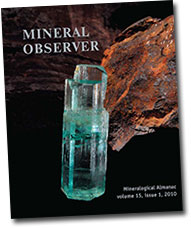 |
In December, we featured Will The Younger’s report on the phenomenon of Mineralientage München. This month, another world-class venue, Tucson, will feature the appearance of the elder Larson’s take on the Munich show, courtesy of the Russian journal, Mineralogical Almanac. If all goes as planned, the Almanac’s Ludmila Cheshko and Michael Leybov will have copies in tow, at the show.
We’ve seen a proof of the nicely illustrated article, which shines the spotlight on the Indian Exposition, the centerpiece of the 2009 Munich show. Munich this year featured some colossal mineral specimens. “It’s amazing to see the many tons of relatively perfect Indian mineral specimens which would be somewhat common if not for their enormous size,” Larson writes. “There are Stilbites, Quartzes, Quartz geodes, Calcites, Apophyllite in large formations rarely seen.”
As we stressed in our pre-show news item in October, the Munich show has much to offer fans of colored gemstones. A companion article by Jacques Touret, of Paris’s Musée de Minéralogie–Ecole des Mines, includes a page of faceted and sculpted beauties: luscious Mahenge spinels, 25–40 carats, and two aquamarine carvings—a 15–20-cm gold-beaked, sapphire-sighted falcon perched on a ruby-topped pedestal of gold and jasper, and a “frozen” aquamarine, which, at 15,950 carats, surely melted the hearts of its viewers.
See Mineralogical Almanac for more information. [back to top]
— End February Newsletter • Published 2/5/10 —